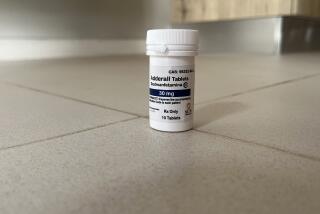In Mexico, the Pharmacist Is Often the Source of Both Diagnosis and Prescription
- Share via
MEXICO CITY — At a pharmacy in the working-class neighborhood of Tacubaya one morning, Maria Luisa Hernandez was huddled in conference with the young man behind the counter.
Beside her stood her 10-year-old son, Manolo, his face wracked with pain and his hands clutching his belly.
“His stomach has hurt for two days now, and he developed diarrhea last night. What can I do?” Hernandez asked the clerk.
The man leaned over the counter to look at the boy.
“Is it a dull ache or a sharp pain in your stomach?” he asked.
“It’s a big pain, and I have it all the time,” the boy replied.
The clerk went into the back of the store and returned with a small, thin box.
“Give him one of these pills every six hours for two days and keep him in bed,” he said to Hernandez, who paid him 1,088 pesos (about 80 cents), and left the store.
Printed on the box of medicine, called Chloromycetin, were the words: “Sale requires a prescription. Administer only according to the instructions of a physician.”
Common Practice
Similar scenes are played out every day at pharmacies throughout Mexico City and in small towns and villages all over the country. In Mexico, as in most Latin American countries, the tradition of self-treatment is an often-used alternative to professional medical consultation.
“Many Mexicans, for economic and historical reasons, avoid doctors and instead go directly to the pharmacy when they are sick,” said Dr. Francisco Estrada, 32, a family medicine specialist. “It is understandable, although frankly, I end up losing business because of it.”
Estrada said many people “lack education and are very traditionalist in their thinking. They are not used to consulting professionals to help them with their problems.”
The advantages of avoiding a doctor are obvious.
“Doctors charge fees that are out of reach for many people. And in the countryside, there are few doctors because so many are concentrated in the cities,” Estrada said.
“Going to a pharmacy is the next best thing--and the consultation is free,” he added.
Private doctors charge between 8,000 pesos and 12,000 pesos--about $6 to $9--for an office visit. That cost is too high for many Mexicans, many of whom earn the minimum daily wage of 3,665 pesos, or about $2.90.
For the employed, the government’s Social Security Institute operates public health clinics where diagnoses and prescriptions are given free of charge.
But the time spent waiting for a doctor at a clinic discourages many who suffer from minor illnesses, so they head for the pharmacies.
“All kinds of people come in here, rich and poor, complaining of many things--fever, vomiting, nausea, dizziness and so on. I usually know what to give them,” said Juan Bustamente Melgar, 42, an employee of Farmacia Max in the working-class Observatorio neighborhood.
No Degree
Bustamente said he studied pharmacology for two years but never received a degree.
“I’d say I’m far more qualified to recommend a remedy than most people working in pharmacies,” he said. “I act responsibly--if someone has something serious, or if I’m not sure what to recommend, I won’t sell them anything. I’ll tell them to see a doctor.”
Not all pharmacies are as scrupulous.
“I know some places that will sell the customer just about anything, as long as it’s remotely useful in curing the ailment. The profit motive is very, very strong,” said Soila Anzures, 30, an employee at the pharmacy of the Mocel Hospital, in an upper middle-class neighborhood.
More to Read
Sign up for Essential California
The most important California stories and recommendations in your inbox every morning.
You may occasionally receive promotional content from the Los Angeles Times.













